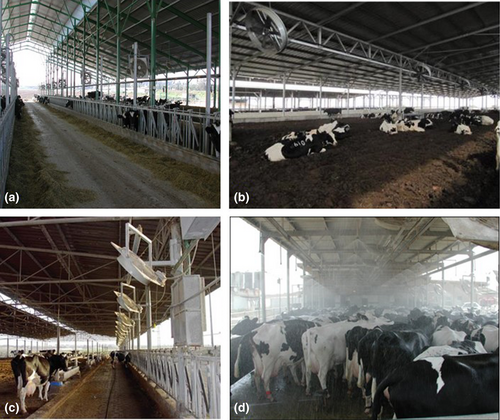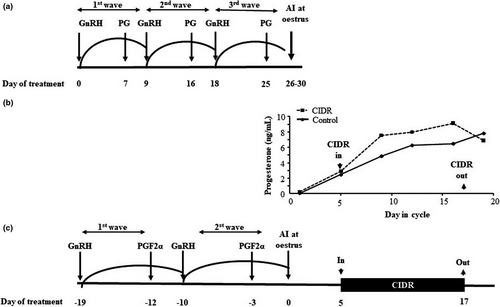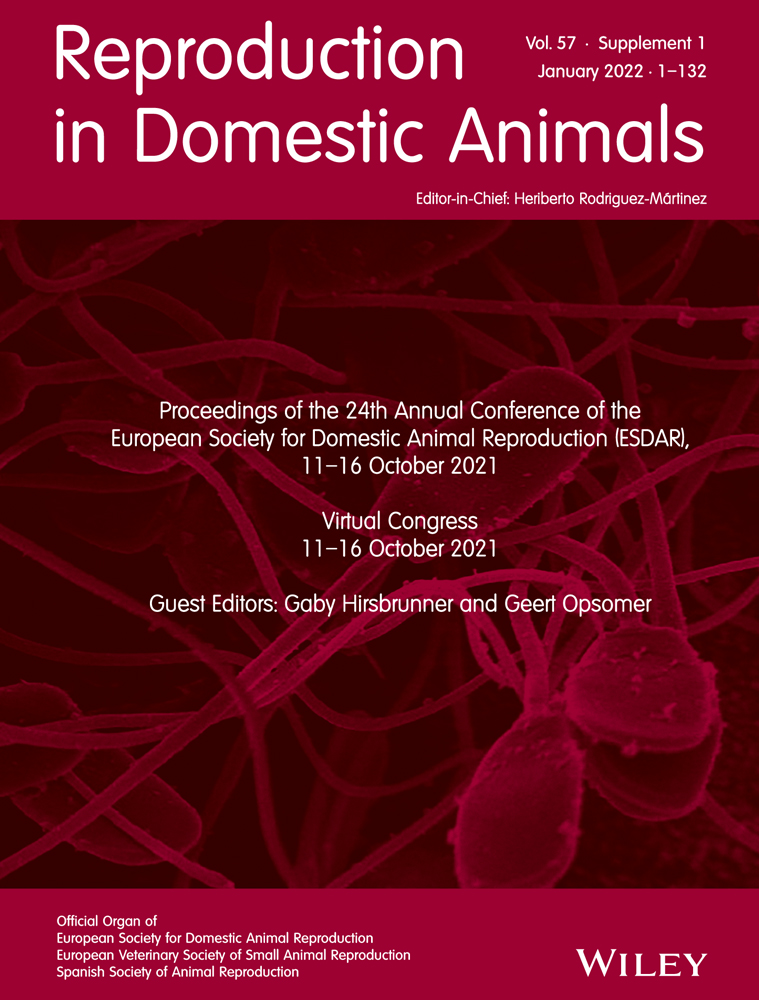Cooling is the predominant strategy to alleviate the effects of heat stress on dairy cows
[Correction note: The acknowledgement section has been included in this version]
Abstract
Reduced reproductive performance of lactating cows during the summer is associated mainly with intensive genetic selection for high milk production, which places a great load on the thermoregulatory mechanism. In the last decades, a big effort has been made to explore the mechanism by which heat stress compromises fertility. The data gained so far revealed that the effect of thermal stress on the female reproductive tract is multifactorial in nature. Based on this understanding, new strategies to mitigate the effect of heat stress have been developed. The review summarizes some of the physiological responses of the cow to elevated temperature and discusses its limitations to maintain normothermia. The review emphasizes that cooling is the predominant strategy used today to alleviate the effects of heat stress. Findings from the Israel dairy herd indicate that efficient cooling management can improve milk production during the summer to a similar level of the winter, expressed by summer to winter ratio of 0.98. However, cooling as a singular approach cannot eliminate the decline in reproduction. Nonetheless, an efficient cooling system is a prerequisite for any other strategy. The review suggests additional hormonal treatments to improve reproductive performance during the summer. Given the complexity of heat stress effects on reproduction, comprehensive reproductive management during the summer is suggested, that is combining two or more strategies in a programme, might be more beneficial.
1 INTRODUCTION
Heat stress is not confined only to hot regions. Environmental thermal stress in cooler regions, such as Europe, has been recently reported (Pasqui & Di Giuseppe, 2019). Moreover, the effects of heat stress are not limited to the hot months, as they carry over to the following cooler months (autumn), resulting in long-term effects throughout the year (Al-Katanani, Paula-Lopes, & Hansen, 2002; Zeron et al., 2001). A period of two to five oestrous cycles (40–105 days) is required for recovery from summer heat damage and the appearance of competent oocytes in the subsequent autumn (de S Torres-Júnior et al., 2008; Roth et al., 2001). This long-lasting effect of heat stress on the ovarian pool of oocytes might explain the reduced fertility during the autumn, when cows are not exposed to environmental thermal stress. Reduced fertility through four to six months of the year which inflicts heavy economic losses to the dairy industry (St-Pierre, Cobanov, & Schnitkey, 2003).
In the last decades, a big effort has been made to explore the mechanism by which heat stress compromises fertility (Hansen, 2019). The data gained so far, revealed thermal stress affects the female reproductive tract is multifactorial in nature, characterized by alterations in the hypothalamus–pituitary–ovarian axis. Among the components of the female reproductive tract, the ovarian pool of follicles is highly sensitive to thermal stress (Paes et al., 2016; Roth, 2017). Impaired growth and function of the small antral follicles can be expressed weeks later by compromised functioning of the dominant and preovulatory follicles (Badinga, Thatcher, Diaz, Drost, & Wolfenson, 1993; Wolfenson, Lew, Thatcher, Graber, & Meidan, 1997; Wolfenson et al., 1995). These alterations might in turn impair the cascade of events leading to ovulation and formation of the corpus luteum (CL). Moreover, while heat stress can directly affect the developing embryos (for review see Hansen, 2007), it can also affect embryonic development, indirectly, by attenuating oocyte developmental capacity. Understanding the mechanism by which heat stress impairs reproductive processes has led to the development of some strategies to mitigate the effects of heat stress.
2 DIRECT COOLING AND INDIRECT COOLING
The ability of the cow to maintain normothermia depends on the environmental condition, from one hand, (solar radiation, ambient temperature, relative humidity and wind speed) and on its metabolic heat production, from the other hand (Collier, Renquist, & Xiao, 2017). When the body temperature is above the ambient temperature, thermal gradient is formed and heat exchange from the body to the environment occurs. However, when the environmental temperature meets or exceeds the body temperature, additional physiological (sweating and panting), behavioural (standing) and metabolic changes (Collier & Gebremedhin, 2015). Given the limitations of the cow's physiological responses to alleviate the effects of heat stress, relief interventions have been developed and implanted in farm, based on two main approaches, indirect cooling and direct cooling (Figure 1).

2.1 Indirect cooling
The rational of the indirect cooling is reducing the environmental temperature surrounding the animal in order to keep a thermal gradient and to enable heat exchange. The primary and mandatory means is providing shed in the housing area. The total incoming radiation is compared to 174 W/m2 heat production of a cow yielding 35 kg milk/day (Berman, 2003, 2004). Provision shade would reduce the radiant heat load from the upper hemisphere by 30%–70%, depending on shade quality. Exposing cows with black air coat to direct solar radiation increased their coat and body temperature (42.9°C and 39.1°C, respectively) relative to that when they were in shad (37.6°C and 36.8°C, respectively; Gebremedhin, Hillman, Lee, & Collier, 2007). Recommended shade allowances are 1.8–2.5 m2 per cow for dry area (Hahn, 1981) and 3.5–5.6 m2 percow for more humid area (Armstrong, 1994; Buffington, Collier, Canton, & Abstract, 1983). A large shade area also reduces the radiated heat from the cows (Gebremedhin & Wu, 2003) and reported to reduce aggressive encounters between cows and to increase lying time (Schütz, Rogers, Poulouin, Cox, & Tucker, 2010). In Israel, cows are housed in a large shaded area (16–22 m2 per cow) under a high roof shelter (Figure 1a). The high natural air velocity to which the roof is exposed reduces its temperature thereby radiation to the animals (Berman, 2012).
Evaporative heat loss, that is evaporation of water from the skin surface (sweating) and water loss through respiration (panting), is affected by relative humidity, thermal and solar radiation but also by wind velocity. Wind greatly increases evaporative cooling of the skin surface by penetrating the hair coat and reducing its effective thermal resistance (Berman, 2004). Increasing air velocity over the cow from about 0.2–0.9 m/s increases sweating rate (Hillman, Gebremedhin, Parkhurst, Fuquay, & Willard, 2001), thereby reduce rectal temperature. In light of this, forced ventilation, another indirect cooling mean, is widely used for improving thermal balance of the cow (Figure 1b). For instance, high-volume low-speed fans and low-volume high-speed fans (Smith & Harner, 2012) have been introduced into the housing area. Low profile cross-ventilated freestall building (Smith & Harner, 2012; Smith, Harner, Bardford, Overton, & Dhuyvetter, 2008) also provides a good control over the cow's environment and enables the animal to keep a stable core temperature (Smith et al., 2008). Indirect cooling with water to cool the air around the cow is also performed by using tunnel or cross-ventilation with evaporative pads, and a combination of fans and high-pressure sprayers (Smith & Harner, 2012). Nevertheless, indirect cooling, with or without water, is not sufficient to alleviate thermal stress in high producing cows, reflected by decline in conception rate during the hot season (Flamenbaum & Ezra, 2003).
2.2 Direct cooling
The rational of direct cooling is to extract heat by forced evaporation from the animal surface. Direct evaporative cooling by wetting the cow with water and evaporating the water with fans was introduced (Flamenbaum, Berman, & Wolfenson, 1984) and proved to be highly efficient in alleviation of heat stress from high lactating (Berman & Wolfenson, 1992; Flamenbaum & Galon, 2010). Direct evaporative cooling can be executed in the holding area (before milking; Figure 1c) and along the feeding area (Figure 1d) at specific time window when most of the cows approaching the feeding line. The cooling programme should be used according to the need and the severity of thermal stress (i.e., intensity and duration). In dry climates, evaporative cooling can reduce air temperature by 15°C; however, its use is limited by ambient humidity of 70%–75% (Berman, 2009). The number and the duration of cooling periods and the interval between periods play a pivotal role in preventing hyperthermia. In Israel, cooling management which based on seven cooling periods a day (30-min each) can maintain normal body temperature in cows producing 30 kg milk/day and to keep the conception rate similar to that in the winter (Wolfenson, Flamenbaum, & Berman, 1988). On the other hand, intensive cooling consisted of 10 cooling periods is required to prevent the decline in milk production in high-yielding cows (>13,000 kg/year; Flamenbaum & Galon, 2010). Comparing the effect of five- versus eight-cooling periods, 45 min each, revealed that eight cooling periods improved the physiological and behavioural responses, expressed by lower rectal temperature reduced respiratory rate, increased lying and rumination time (Honig et al., 2012). Moreover, eight cooling period increased the dry matter intake (27.0 kg/day vs. 24.7 kg/day, respectively) and improved milk production (40.1 kg/day vs. 36.6 kg/day).
The efficiency of the cooling system can be evaluated on farm by measuring the rectal or vaginal temperature of selected cows. Continuous measurements of body temperature by vaginal logger provide the vaginal temperature without interfering the cow behaviour. Data from this system enable to evaluate the efficiency of the cooling management. Accumulated hours of vaginal temperature above 39°C (Lavon et al, unpublished) and the number of high rectal temperature occurrence before and on the insemination day (Pereira et al., 2013), both are variables that negatively correlated with pregnancy rate. On an annual base, the efficiency of the cooling system can be evaluated by calculating the ratio between summer and winter for milk production. Data from the Israel Dairy herd (2019) indicate that under efficient cooling management, the summer-to-winter ratio is 0.98 for milk production and 0.97 for economical corrected milk, that is the amount of milk produced and adjusted to 3.5% fat and 3.2% protein. However, conception rate during the summer was lower by 18.5% relative to the winter (22.5 vs. 41.0, respectively), with a winter-to-summer ratio of 0.55 (Israel herd book, 2019).
3 HORMONAL STRATEGIES TO IMPROVE SUMMER FERTILITY
In the last few decades, major efforts have been made to explore the mechanism by which heat stress compromises fertility. The data gained so far, have revealed that various reproductive tissues are heat sensitive (Wolfenson, Roth, & Meidan, 2000), and can be impaired even by a slight elevation of the body temperature (Gwazdauskas, Thatcher, & Wilcox, 1973). Alterations have been documented in the hypothalamus–pituitary–ovarian axis, in particular on gonadotropin (GnRH- gonadotropin realizing hormone, LH- luteinizing hormone, FSH- follicular stimulating hormone) and steroids (androstenedione, estradiol, progesterone) secretion (for review, see Wolfenson et al., 2000). The ovarian pool of follicles and their enclosed oocytes as well as the dominant and the preovulatory follicle and the corpus luteum are highly sensitive to thermal stress (for review, see Roth, 2017). Heat stress can affect embryonic development indirectly by attenuating oocyte developmental capacity, or by direct effects on the developing embryos (for review, see Hansen, 2013). Based on this understanding, several reproductive strategies have been developed. A few of them have the potential to come into practice to mitigate the effects of heat stress.
Timed artificial insemination (AI) is one of the practical strategies, which might be used in very hot zones, to increase the number of inseminated cows before the hot season. In normothermal conditions, this approach can achieve a pregnancy rate per AI of 40% (Santos, Narciso, Rivera, Thatcher, & Chebel, 2010). Moreover, applying timed AI during the hot season increased the pregnancy rate, at 120 days post-partum, by 10 percentage units relative to insemination on oestrus. The interval from calving to the first insemination, the 'open days' and the conception rate were also improved (de la Sota et al., 1998).
Administration of GnRH on oestrus, to control the ovulation timing, has been reported to increase conception rate during the summer by 11 percentage units (Ullah et al., 1996). GnRH injection, within two hours from onset of standing oestrus, increased conception rate during the summer and autumn from 41% to 56% (Kaim et al., 2003). It should be noted, however, that successful hormonal manipulation can be achieved when an efficient cooling system is utilized and cows maintain normothermia throughout most of the days' hours.
Administrating GnRH or human chorionic gonadotropin (hCG) post-insemination is another approach to increase plasma progesterone by forming an accessory corpus. Plasma progesterone concentrations during the summer are lower than those during the spring or winter (Howell, Fuquay, & Smith, 1994; Wolfenson et al., 2002) and might affect embryonic survival during early stages of development (Robinson, Hammond, Wathes, Hunter, & Mann, 2008). Administration of GnRH between days 5 and 15 post-AI increased conception rate during the warm season, by approximately 15 percentage units (López-Gatius, Santolaria, Martino, Delétang, & De Rensis, 2006; Willard et al., 2003). Similarly, administration of hCG on day 5 or 6 post-AI increased conception rate during the summer by 13 percentage units. Nonetheless, using hCG or GnRH on day 5 post-AI, improved conception rate in cows that developed moderate hyperthermia, but not in those that developed severe hyperthermia (Beltran & Vasconcelos, 2008).
Supplementation of exogenous progesterone at the very early stages of pregnancy has been suggested to overcome luteal insufficiency. Administration of intravaginal device containing progesterone (CIDR) on day 5 ± 1 post-AI, for 13 days, increased the conception rate, by 26 and 22%, in a sub-group of cows with low body condition at the peak of lactation and in those exhibited uterine disorders at parturition, respectively (Friedman, Roth, Voet, Lavon, & Wolfenson, 2012). A pronounced increase was recorded in cows characterized by both, low BCS and post-partum reproductive. A follow-up study in which CIDR was selectively inserted only to these sub-groups of cows to cows with confirmed these findings (Shiff, Lavon, Wolfenson, & Roth, 2018).
Fertility data have shown that the depressive effect of summer heat stress extends to the autumn. Given that follicular growth is a long-lasting process, a carryover effect on the ovarian follicles and their enclosed oocytes is suggested.
Nonetheless, the effect is transient in nature, as spontaneous recovery of oocyte developmental competence (Al-Katanani et al., 2002; Roth et al., 2001). The conception rate also increases from the summer (20%) through the autumn (28%) to the winter (39%; Zeron et al., 2001). It is suggested that only a subpopulation of the ovarian antral follicles, rather than the entire follicular reservoir is damaged upon exposure to summer heat stress therefore, enhanced removal of impaired follicles has been suggested to improve oocyte competence (Roth et al., 2001). Frequent aspiration of small- and medium-sized follicles (3–7 mm) led to earlier emergence of healthy follicles and competent oocytes (Roth et al., 2001). FSH administration increased the number of medium-sized follicles and induced an earlier emergence of grade-I oocytes (Friedman, Glick, Lavon, & Roth, 2010; Roth, Arav, Braw-Tal, Bor, & Wolfenson, 2002). Induction of several follicular waves by repeated injections of GnRH and PGF2α eliminates the disruptive effect of heat stress on follicular function (Guzeloglu et al., 2001) and increased estradiol content in the preovulatory follicle (Roth, Bor, Braw-Tal, & Wolfenson, 2004). Induction of three consecutive follicular waves improved the conception rate during the summer and autumn. In particular, an increase of 15 and 16 percentage units was recorded in first-calving cows and cows with high body condition score post-partum, respectively (Friedman, Voet, Reznikov, Dagoni, & Roth, 2011). Hormonal treatment before (GnRH + PG) and after (CIDR) AI combined with efficient cooling system improved fertility in subpopulations of dairy cows during the summer and autumn (Friedman, Voet, Reznikov, Wolfenson, & Roth, 2014; Figure 2). Again, a positive effect of the treatment was expressed when efficient cooling was evident, that is, cows exhibited a mild rise in body temperature in the afternoon.

4 SUMMARY
Using an efficient cooling system to maintain normothermia is a prerequisite to any additional remedial approaches. Hormonal treatments to synchronize ovulation (GnRH, hCG), or to enhance removal of impaired follicle (GnRH + PG) or to support corpus luteum functioning and embryonic survival (CIDR), are more efficient if the cow maintains normal body temperature. Given that the effect of heat stress on fertility is multifactorial in nature, a comprehensive management which includes efficient cooling system and hormonal treatment targeted to sub-group of cows is suggested for improving the fertility of high lactating cows during the summer.
ACKNOWLEDGEMENTS
The author would like to thank Prof. (emeritus) Amiel Berman, Prof. (emeritus) David Wolfenson and Dr. Israel Flamenbaum, three generations of science, for their tremendous contribution to the study of heat stress in dairy cows.
CONFLICT OF INTEREST
None of the authors have any conflict of interest to declare.
AUTHOR CONTRIBUTION
Roth Z wrote the entire review paper alone.




